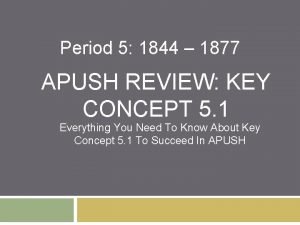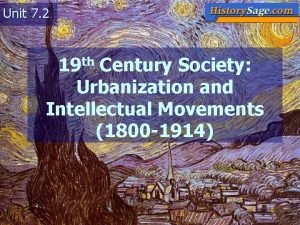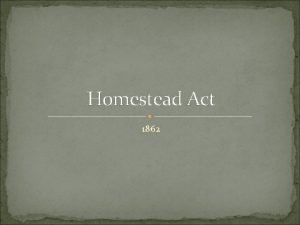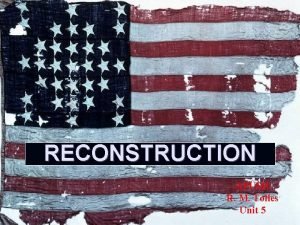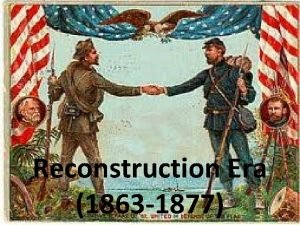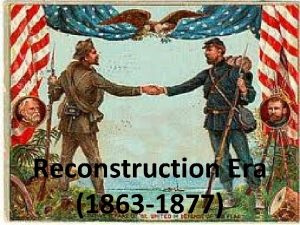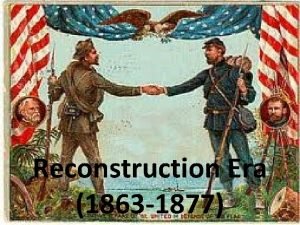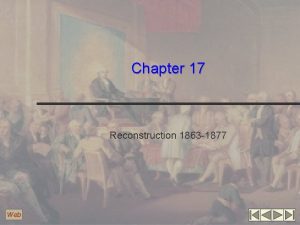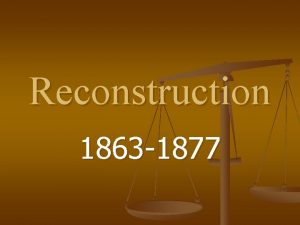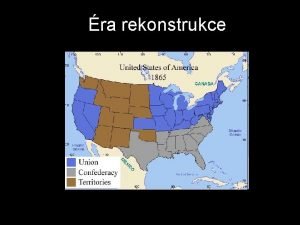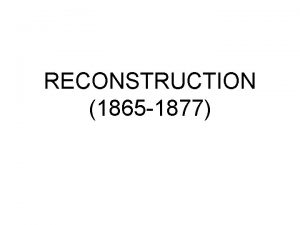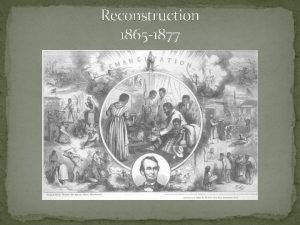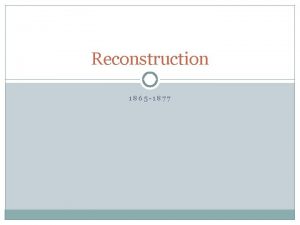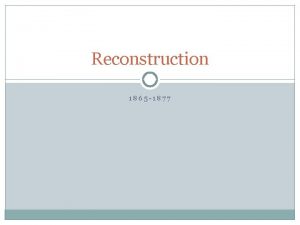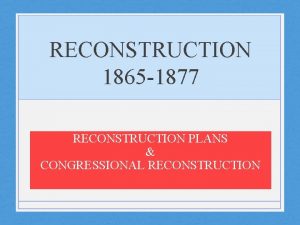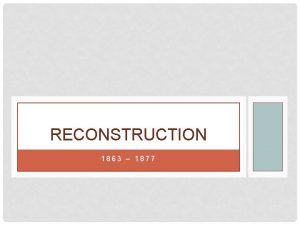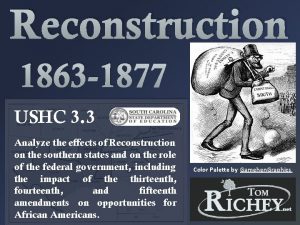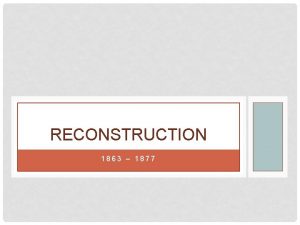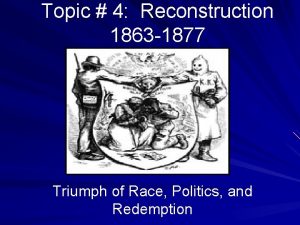Reconstruction 1863 1877 APUSH Lecture 4 D covers



























- Slides: 27

Reconstruction, 1863 -1877 APUSH Lecture 4 D (covers chapter 15) Ms. Kray Some slides taken from Susan Pojer

The Problem of Peacemaking “Presidential Reconstruction”

A Devastated South and the Process of Re-Integration #1 - How do we bring the South back into the Union? #3 - How do we integrate and protect newly emancipated black freemen? #2 – How do we rebuild the South? #4 – Which branch of government should control the reconstruction process?

Lincoln’s 10% Plan, 1863 �Based on Proclamation of Amnesty and Reconstruction � Full presidential pardons to most southerners who � (1) took an oath of allegiance to the Union and the U. S. Constitution � (2) accepted the emancipation of slaves (13 th Amendment) � A state government could be reestablished and accepted as legitimate by the U. S. president as soon as at least 10% of the voters in that state took the loyalty oath � Deliberately lenient in order to shorten the war �Wade-Davis Bill, 1864 � Radical Republicans in Congress thought Lincoln’s plan was too lenient � Required 50% of voters to take loyalty oath and permitted only non -Confederates to vote for a new state constitution � Lincoln pocket vetoed

Conservative vs. Radical Republicans Conservatives � Insisted that the South accept the abolition of slavery but had few other conditions Radicals � Led by Thaddeus Stevens and Charles Sumner � Punishment for civil &military leaders of the Confederacy � Disenfranchisement of Southern whites � Protection of black legal rights � Confiscate property of wealthy white Southerners who had aided the confederacy to be distributed to freedmen. � Some even favored granting blacks the right to vote.

Lincoln Assassinated, 1865 �Lincoln’s reconstruction plans ended when he was assassinated by John Wilkes Booth �His VP, Andrew Johnson, now president

Andrew Johnson’s 10%+ Plan �Johnson was a former Democrat and Tennessee governor �White supremacist � “Damn the negroes! I am fighting these traitorous aristocrats, their masters!” �Disliked Southern planter aristocracy �Johnson’s Plan �Kept original components of Lincoln’s 10% plan plus a few other ideas �High-ranking Confederate officials and any southerner with property worth more than $20, 000 were disenfranchised �President could pardon “disloyal” southerners

Freedman’s Bureau, 1865 � Acted as a welfare agency for blacks and whites � Had authority to resettle blacks on land confiscated from “disloyal” Southerners � Freedmen promised 40 acres and a mule � Greatest Success: Education � Established more than 3, 000 schools � Taught 200, 000 Freedmen and women to read � Freedmen’s Bureau Through Southern Eyes – “Plenty to Eat and Nothing to Do”

“Who Won the War? ” Growing Northern Alarm VP of Confederacy, Alexander Stephens became Senator Alexander Stephens of Georgia � 8 months after Johnson 10% plan announced all 11 Confederate states qualified to re-enter the Union � Johnson had granted 13, 500 pardons; planter aristocracy back in power � Southern Defiance: The Black Codes � Passed by Southern state legislatures � Intended to place limits on socioeconomic opportunities and freedoms open to Black people � Prohibited blacks from renting or borrowing money to buy land; from testifying against whites in court � System closely resembled slavery

“Radical” Reconstruction, 1866 -1872 Congress Takes Command

Congress Breaks with Johnson � Congress bars Southern Congressional delegates from taking office � Late 1865: Joint Committee on Reconstruction est. � Asserted Congress not the President had authority over Reconstruction � Johnson vetoes Freedman’s Bill (1866) & Civil Rights Act (1866) � Congress passes both over his veto – 1 st time ever � Mid-Term Election of 1866 � Johnson campaigns against the Radical Republicans and appeals to racial prejudice in his “swing around the circle campaign” � Plan backfires � Radical Republicans gain a 2/3 majority in both Houses by “waving the bloody shirt”

The Congressional Plan, 1867 � Military Reconstruction Act � Former Confederate states under military occupation � Black suffrage and ratification of the 13 th and 14 th Amendments required in all new state constitutions � Later 15 th Amendment added as well � Punishment of Confederate leaders became policy � Tenure of Office Act � Placed restrictions on the power of President Johnson � Not allowed to fire a cabinet member w/o permission of Congress � Command of Army Act

President Johnson Impeached, 1868 �Feb. 1868: President Johnson fires Sec. of War Edwin Stanton �House of Representatives votes to impeach Johnson before charges have even been drawn up! �Trial lasted 11 weeks � Johnson acquitted by one vote � 7 Republicans join with the Democrats to prevent expulsion � Did not want to set the precedent of removing a president for political reasons

The Radical Republican’s Legacy: The Reconstruction Amendments � Radical Republicans feared much of what they had done could be repealed looked for a more permanent solution – Southern states must accept amendments before readmitted to the Union � 13 th Amendment � Prohibited slavery � 14 th Amendment � Declared all persons born or naturalized in the U. S. were citizens � Provided for equal protection of the laws for all citizens � Enforced congressional legislation guaranteeing civil rights former slaves � 15 th Amendment � Prohibited any state from denying or abridging a citizen’s right to vote on account of race, color, or previous condition of servitude � Congress given the power to enforce this article � Women’s rights groups furious they were not included

The South in Reconstruction

Southern Reconstruction Governments �The Republican party organized and dominated the government’s of the ex. Confederate states �Scalawags � Southern Republicans who supported the Reconstruction governments �Carpetbaggers � Northern newcomers who came to lead the Reconstruction governments � Accused by Southerners of corruption �Southern strongly resented this Northern interference

The Myth of “Negro Rule” �African American freedmen made up the largest block of Republican voters in the South �Freedmen begin being elected to state legislatures and to Congress � 2 U. S. Senators and more than a dozen U. S. Congressmen �White southerners unprepared to give freed blacks political power �Complained about “negro rule” �No such thing existed in any southern states � No black governors, no black control of state legislatures

Evaluating the Reconstruction Governments Accomplishments Failures ü Liberalized state const. provided for universal suffrage, prop. rights for women, debt relief, & modernized penal codes ü For years, era of Republican rule in the South depicted as utterly wasteful & corrupt ü Promoted building of roads, bridges, railroads, & other internal improvements ü While instances of graft & wasteful spending did occur it was no worse than corruption practiced anywhere else around the country during this time. ü Est. needed state institutions like hospitals and asylums ü Est. state-supported public school systems ü paid for it by overhauling the tax system & issuing bonds

Reconstruction for African Americans �Huge improvements in education � By 1876 more than 50% of all white children and 40% of all black children were attending schools � Efforts at integration failed schools remained segregated � Several “black academies” created to offer advanced education: Fisk, Morehouse �Efforts to rebuild family structures � Attempted to locate lost relatives � Rush to have marriages legalized � Move away from slave cabins

From Slaves to Sharecroppers � Radical Republicans and Reconstruction governments wanted to reform landownership in the South; they failed � By 1880 less than 5% of black were independent landowners � Sharecropping System Developed � Usually entered sharecropping arrangements with their former masters � Led to a cycle of debt and depression � Poor whites also involved in sharecropping

The Crop-Lien System Furnishing Merchant § Loan tools and seed up to 60% interest to tenant farmer to plant spring crop. § Farmer also secures food, clothing, and other necessities on credit from merchant until the harvest. § Merchant holds “lien” {mortgage} on part of tenant’s future crops as repayment of debt. Tenant Farmer Landowner § Plants crop, harvests in § Rents land to tenant in autumn. exchange for ¼ to ½ of tenant farmer’s future crop. § Turns over up to ½ of crop to land owner as payment of rent. § Tenant gives remainder of crop to merchant in payment of debt.

The Abandonment of Reconstruction, 1872 -1877

Reconstruction in the North The Grant Administration, 1869 -1873 � 1868: Republican Ulysses S. Grant becomes president � Won by a very small margin -- 500, 000 black voters in the South made the difference � 15 th Amendment: guaranteed black voting rights �Grant’s Presidency � Material interests of the age replaced the idealism of Lincoln’s generation – main concerns seemed to be RRs, steel, labor problems, and currency debate � Plagued by scandals � � Whiskey Ring – treasury officials and distillers falsified reports of tax revenues Credit Mobilier Scandal – construction company defrauded the federal government of millions of dollars

Why Did Northern Support Wane? �Mounting economic and political problems the country turned away from Reconstruction’s idealistic goals and the overriding Republican goal became continued political dominance � Panic of 1873 � Rise of the Spoilsmen �Concern over westward expansion & the Indian Wars �Social Darwinism argued for inferiority of blacks �General fatigue w/Reconstruction

Rise of the Redeemers �By the end of Grant’s presidency 8 of the 11 Confederate states had been “redeemed” by Democrats �The Invisible Empire of the South �Secret societies like the Ku Klux Klan arose � Used violence and intimidation to exercise white supremacy and to exclude freedmen from exercising their political rights �Congress tried to stop KKK w/Enforcement Acts of 1870 & 1871 � but they were poorly enforced

The End of Reconstruction: The Election of 1876 � A Disputed Election Result � Democrat Samuel Tilden polled more popular votes than Rutherford B. Hayes � Tilden won 184 of the 185 electoral votes needed for election � There were 20 disputed votes in four states, 3 of which were in the South � Special Electoral Commission formed � In a straight party vote 8 -7, the commission gives all 20 disputes votes to Hayes � Democrats in the Senate threaten to filibuster the results

The End of Reconstruction: The Compromise of 1877 �The Democrats agreed that Hayes would take office �The Republicans agreed to withdraw federal troops from the South �Hayes promised to appoint at least one Southerner to his cabinet �The Republicans agreed to support internal improvements in the South �Republicans abandoned their commitment to racial equality � Civil Rights Act of 1875 not enforced � Guaranteed equal accommodations in public places and prohibited racial discrimination in jury selection � Later declared unconstitutional by the Supreme Court in 1883
 Haymarket square riot apush
Haymarket square riot apush Compromise of 1877 apush
Compromise of 1877 apush Hjälper sedan 1863
Hjälper sedan 1863 Manet, olympia, 1863
Manet, olympia, 1863 Edouard manet olympia 1863
Edouard manet olympia 1863 July 1-4 1863
July 1-4 1863 Nov 19 1863
Nov 19 1863 Edouard manet olympia 1863
Edouard manet olympia 1863 Olympia, 1863
Olympia, 1863 Second industrial revolution timeline
Second industrial revolution timeline Homestead act of 1863
Homestead act of 1863 During the free banking era between 1837 and 1863
During the free banking era between 1837 and 1863 Edouard manet olympia 1863
Edouard manet olympia 1863 Constitucion de 1863
Constitucion de 1863 Manet, olympia, 1863
Manet, olympia, 1863 Edouard manet olympia 1863
Edouard manet olympia 1863 Reconstruction apush
Reconstruction apush Proclamation of amnesty and reconstruction apush
Proclamation of amnesty and reconstruction apush Treaty of versailles apush def
Treaty of versailles apush def 01:640:244 lecture notes - lecture 15: plat, idah, farad
01:640:244 lecture notes - lecture 15: plat, idah, farad Whats the compromise of 1877
Whats the compromise of 1877 The gilded age 1877 to 1898 worksheet answers
The gilded age 1877 to 1898 worksheet answers Compromise of 1877
Compromise of 1877 1877 golden 1
1877 golden 1 Great railroad strike of 1877 significance
Great railroad strike of 1877 significance Gilded age strikes
Gilded age strikes Tanssija 1877-1927
Tanssija 1877-1927 1877-1865
1877-1865

